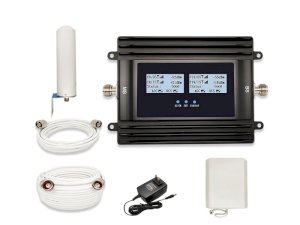
You’ve invested in a mobile signal booster and a powerful external antenna to combat frustratingly weak signals. But the quality of your mobile connectivity isn’t just down to the external antenna and the signal booster—it’s also significantly influenced by the seemingly simple 4G antenna coaxial cable that connects them. This coaxial cable carries the amplified signal, and a poor choice can choke your system’s performance, leaving you with suboptimal results.
This guide helps you navigate the world of coaxial cables, explaining key specifications and guiding you to select the best option for the 4G antenna setup, ensuring you receive the fastest, most reliable mobile data and calls.
mobile signal booster LCD-300GD
+ FREE Lightning Surge Protector
for United States
4.9/5 — 278 Reviews
Why does the right coaxial cable matter for 4G?
Think of the coaxial cable as a vital conduit and the “lifeline”, connecting your external antenna to the signal booster. It carries the improved radio signal, allowing you to reap the benefits of your investment. A poor-quality coaxial cable can cause:
- Signal losses as the radio signal travels. A good cable makes signal transmission far better.
- Interference like unwanted noise can creep into the radio signal, reducing clarity and performance.
- Inefficient performance that happens due to the degraded signal. Choosing the right cable is crucial to avoid throttling your system’s potential. Your cable length can influence how well it works.
Key coaxial cable characteristics you need to understand
Several technical specifications determine a coaxial cable’s signal transmission and antenna performance. Below goes a breakdown of the most important ones:
Signal attenuation
Attenuation is the loss of signal strength that occurs as the radio signal travels through the coaxial cable, measured in decibels (db) per meter or foot. Lower attenuation means fewer signal losses, while higher attenuation will result in a weaker radio signal reaching the amplifier unit.
Signal attenuation increases with high frequencies. For the UK’s 4G frequency bands, such as 800 MHz, 1800 MHz, and 2600 MHz, attenuation is the first consideration when choosing a cable.
In the table, we highlight the cable type with the corresponding frequency band and possible attenuation:
| Cable type | Frequency (MHz) | Attenuation (dB/100ft) |
|---|---|---|
| LMR-400 | 800 | ~1.9 |
| LMR-400 | 1800 | ~2.8 |
| LMR-400 | 2600 | ~3.3 |
| RG-6 | 800 | ~4.5 |
| RG-6 | 1800 | ~6.5 |
| RG-6 | 2600 | ~7.5 |
Impedance
Impedance is the resistance of the cable to the flow of an electrical current. The typical coaxial cable’s impedance for 4G systems is 50 Ohms. Impedance mismatch leads to signal reflections and a reduction in signal quality.
Voltage standing wave ratio (VSWR)
VSWR is a measurement of the impedance mismatch in a coaxial cable. Lower VSWR— ideally less than 1.5:1—means good impedance matching and maximum signal transmission, with no signal losses.
Shielding
The cable’s ability to block electromagnetic interference (EMI) and prevent signal leakage is shielding. Good shielding protects the radio signal from external noise as well as prevents the interference of the radio signal with other electronic and mobile devices.
There are single, double, and triple shielded cables that offer better levels of protection, propelling the performance of electrical circuits.
Conductor material
Conductor material is utilized for the center conductor wire within the coaxial cable. Copper is the best conductor, providing the lowest signal loss. Copper-clad steel is often used to reduce cost, but it has higher signal loss, which affects the power of the signal transmission.
Weather resistance
The ability to resist the elements is a key characteristic of the cable as well. If you set up the coaxial cable outdoors, it must have a weatherproof connector and a weather-resistant jacket to protect it from UV rays, moisture, and temperature fluctuations.
Types of coaxial cable for 4G amplifiers
Let’s explore the most commonly used types of coaxial cables for 4G external antenna systems. Always consider the frequency band before selecting your coaxial cable.
LMR-400
- Traits: Low attenuation, excellent shielding, durable, considered a high-quality coax cable.
- Pluses: Best choice for longer cable runnings, minimizing signal loss. Long-distance signals are best delivered by this cable.
- Minuses: More expensive than other options.
- Considerations for the UK: Often considered the “gold standard” for professional 4G antenna installation. A good LMR-400 alternative is LMR-240. It offers lower signal loss but might not be available in all lengths.
RG-6
- Traits: Widely available, relatively inexpensive, and easy to work with.
- Pluses: Suitable for shorter cable lengths, under 10-15 meters. A good choice for a specific application.
- Minuses: Higher attenuation than LMR-400, not ideal for long distances.
- Considerations for the UK: Commonly used for cable television installations.
RG-8/RG-11
- Traits: Better than RG-6, but worse than LMR-400.
- Considerations for the UK: Can be used for medium cable length cable runnings.
RG-58
- Traits: High attenuation, not suitable for 4G antenna installation.
- Considerations for the UK: Avoid this cable type if possible, especially when dealing with higher frequencies.
Choosing the right cable length
Now, let’s talk about how to pick the correct length for your cable:
- Use the shortest cable length possible to reduce signal loss. Remember, cable loss 4G can be significant.
- Measure the required cable length from the external antenna to the amplifier and add a little extra for flexibility.
- Utilise a table like the one above to estimate signal loss based on the cable type, cable length, and frequency.
What about connectors?
The right connectors are also vital for the performance of your 4G booster system:
- Utilise SMA and N-type connectors.
- Seek top-quality connectors with good contacts and which ensure impedance matching.
- Make sure connectors are properly installed with proper impedance matching and a weather-tight seal. Use a weatherproof connector to help.
Installation and maintenance tips
To guarantee your coaxial cable lasts long, adhere to the following advice:
- Don’t bend the coaxial cable tightly since this can break its internal structure, increase signal losses, and affect the transmission of the signal.
- Protect the cable from sunlight, animal bites, and other physical damage.
- Examine the coaxial cable and connectors regularly for any signs of damage or corrosion.
Conclusion
Selecting the right 4G antenna coaxial cable is a vital step to achieve optimal antenna performance for your mobile signal booster. To transmit signals more effectively and consistently, pick the best coaxial cable for 4G antenna with our helpful article.
FAQs
How do I install connectors on the cable?
Utilise the correct tools and follow the manufacturer’s instructions. Also, there are many helpful videos online that demonstrate the process.
My cable length is 20 meters long. Which cable should I install?
LMR-400 is usually best to have minimal signal loss for a cable run of 20 meters.
What is the difference between single, double, and triple shielded cable?
The number of shielding layers determines the cable’s resistance to EMI. Triple-shielded cable offers the highest level of protection.
How do I determine if my coaxial cable has been broken?
Examine your coaxial cable on a regular basis for cracks, cuts, or kinks. Plus, check the connectors for corrosion or loose connections. If you suspect the cable is damaged, replace it.
Do I better use RG-58 for my 4G external antenna?
Well, RG-58 is inappropriate for 4G external antenna systems because of its high attenuation, which limits signal strength.
I’m using a long cable run. Will that affect my data speeds?
Yes, longer cable runnings result in more signal loss. Using a low-loss type of the cable like LMR-400 and keeping the cable length as short as possibly can will minimize the effects on your data speeds and call quality.










